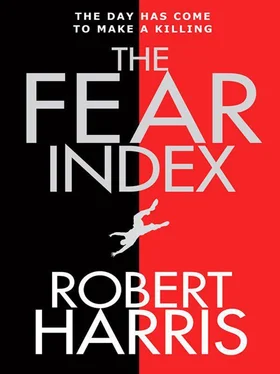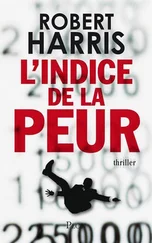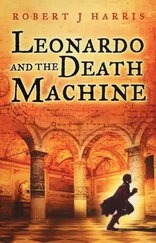Robert Harris - The Fear Index
Здесь есть возможность читать онлайн «Robert Harris - The Fear Index» весь текст электронной книги совершенно бесплатно (целиком полную версию без сокращений). В некоторых случаях можно слушать аудио, скачать через торрент в формате fb2 и присутствует краткое содержание. Жанр: Триллер, на английском языке. Описание произведения, (предисловие) а так же отзывы посетителей доступны на портале библиотеки ЛибКат.
- Название:The Fear Index
- Автор:
- Жанр:
- Год:неизвестен
- ISBN:нет данных
- Рейтинг книги:4 / 5. Голосов: 1
-
Избранное:Добавить в избранное
- Отзывы:
-
Ваша оценка:
- 80
- 1
- 2
- 3
- 4
- 5
The Fear Index: краткое содержание, описание и аннотация
Предлагаем к чтению аннотацию, описание, краткое содержание или предисловие (зависит от того, что написал сам автор книги «The Fear Index»). Если вы не нашли необходимую информацию о книге — напишите в комментариях, мы постараемся отыскать её.
The Fear Index — читать онлайн бесплатно полную книгу (весь текст) целиком
Ниже представлен текст книги, разбитый по страницам. Система сохранения места последней прочитанной страницы, позволяет с удобством читать онлайн бесплатно книгу «The Fear Index», без необходимости каждый раз заново искать на чём Вы остановились. Поставьте закладку, и сможете в любой момент перейти на страницу, на которой закончили чтение.
Интервал:
Закладка:
He shone the torch along it to another door at the far end. Now he could hear clearly the faint hum of CPUs. The ceiling was low and the air was chilled, as in a cold store. He guessed there must be under-floor ventilation as there had been in the computing room at CERN. He walked warily to the end, pressed his palm to the sensor and opened the door on to the noise and lights of a processor farm. In the torch’s narrow beam the motherboards sat on steel shelves that stretched ahead and to either side, exuding the familiar, oddly sweet electrical scent of burned dust. A computer servicing company had attached its sticker to each of the racks: in case of problems please call this number. He walked on slowly, shining his torch to right and left along the aisles, the beam disappearing into the darkness. He wondered who else would have access. The security company, presumably – Genoud’s outfit; building services for cleaning and maintenance; the computer technicians. If each received instructions and payment via email, the place could presumably function independently on outsourced labour alone, without any need of its own workforce: the ultimate Gatesian model of the corporate digital nervous system. He remembered that Amazon in its early days used to call itself ‘a real company in a virtual world’. Maybe here was the logical progression in the evolutionary chain: a virtual company in a real world.
He reached the next door and repeated the procedure with the torch and the recognition sensor. When the bolts had slid back, he paused to examine the door frame. The walls were not structural, he saw, just thin prefabricated partitions. He had imagined, looking at it from the outside, that the building would consist of one big space, but now he realised it was honeycombed: it had a cell-structure like an insect colony. He stepped over the threshold, heard movement to one side, and wheeled round as an IBM TS3500 tape robot rushed towards him along its monorail, stopped, plucked out a disk, and whisked away again. He stood and watched it for a moment, waiting for his heart rate to settle down. He detected a sense of urgent activity. When he moved on, he saw that four other robots were racing to complete their tasks. In the far corner his torch showed an open metal staircase leading to an upper floor.
The adjoining room was smaller and seemed to be the place where the communication pipes came in. He shone his flashlight on two big black trunk cables, the thickness of his fist, emerging out of a closed metal box and descending like tuberous roots into a trench that ran under his feet and up into some kind of switch array system. Both sides of the aisle were protected by heavy metal cages. He already knew that the fibre-optic pipes GVA-1 and GVA-2 both passed close to Geneva airport en route to Germany from the fibre landing site at Marseilles in southern France. Data could be transmitted to and received from New York at the same velocity as particles shot around the Large Hadron Collider – a fraction below the speed of light. VIXAL was astride the fastest communications link in Europe.
The beam of his torch traced other cables running along the wall at shoulder height, partly housed in galvanised metal, emanating from beside a small door. It was padlocked. He fitted the crowbar into the U-shape loop and used it as a lever to wrench the shackle free of its housing. It came away with a shriek, the door swung open and he shone his light into some kind of power control room – electricity meters, a big fuse box the size of a small closet and a couple of trip switches. Yet another video camera regarded him steadily. He quickly flipped the handles on the trip switches down to OFF. For an instant, nothing happened, and then somewhere in the big building a diesel generator shuddered into life and, bizarrely, all the lights came on. Hoffmann, in a fury of frustration, took a swing at the camera lens with the end of his crowbar, poking his tormentor in the eye, smashing it to a satisfactory number of pieces, then set about the fuse board, splintering the plastic casings, only finally giving up when it was obvious he was having no effect.
He turned off the torch and retraced his steps to the comms room. At the far end he presented his face to the sensor, struggling to maintain an even expression, and the door to the next room opened – not another antechamber, it turned out, but a huge open space, with a high ceiling, digital clocks to mark the different time zones and large TV screens, obviously modelled on the trading floor at Les Eaux-Vives. There was a central control unit consisting of a six-screen array and separate monitors showing the output of the security cameras in grid form. In front of it, instead of people, where the quants would have sat there were ranks of motherboards, all processing at maximum capacity to judge by their rapidly flickering LEDs.
This must be the cortex, thought Hoffmann. He stood for a while in wonder. There was something about the absorbed and independent purposefulness of the scene that he found unexpectedly moving, as he supposed a parent might be moved by witnessing a child for the first time unselfconsciously at large in the world. That VIXAL was purely mechanical and possessed no emotion or conscience; that it had no purpose other than the self-interested pursuit of survival through the accumulation of money; that it would, if left to itself, in accordance with Darwinian logic, seek to expand until it dominated the entire earth – this did not detract for Hoffmann from the stunning fact of its existence. He even forgave it for the ordeal it had subjected him to: after all, that had purely been for the purposes of research. One could no more pass moral judgement on it than one could on a shark. It was simply behaving like a hedge fund. Briefly Hoffmann forgot that he had come here to destroy it and bent over the screens to examine the trades that it was putting on. They were being processed at ultra-high frequency in tremendous volumes – millions of shares all held for only fractions of a second – a strategy known as ‘sniping’ or ‘sniffing’: submitting and instantly cancelling orders, probing the markets for hidden pockets of liquidity. But he had never seen it done on such a scale before. There could be little or no profit in it and he wondered briefly what VIXAL was aiming to achieve. Then an alert flashed on to the screen.
It was appearing at that instant in dealing rooms all across the world – 8.30 p.m. in Geneva, 2.30 p.m. in New York, 1.30 p.m. in Chicago:
The CBOE has declared Self Help against the NYSE/ARCA as of 1.30 CT. The NYSE/ARCA is out of NBBO and unavailable for linkage. All CBOE systems are running normally.
The jargon masked the scale of the problem, took the heat out of it, as jargon is designed to do. But Hoffmann knew exactly what it meant. The CBOE is the Chicago Board Options Exchange, which trades around one billion contracts a year in options on companies, indices and tradable funds – the VIX among them. ‘Self Help’ is what one US exchange is entitled to declare against another if its sister-exchange starts taking more than a one-second time period to respond to orders: it is the responsibility of each exchange in the United States to ensure that they don’t ‘deal through’ – that is, offer a worse price to an investor than can be obtained at that precise moment on an exchange elsewhere in the country. The system is entirely automated and operates at a speed of thousandths of a second. To a professional such as Hoffmann, the CBOE Self Help alert gave warning that the New York electronic exchange ARCA was experiencing some kind of system breakdown – an interruption sufficiently serious that Chicago would no longer re-route orders to it under the National Best Bid and Offer (NBBO) regulations, even if it was offering better prices for investors than Chicago.
Читать дальшеИнтервал:
Закладка:
Похожие книги на «The Fear Index»
Представляем Вашему вниманию похожие книги на «The Fear Index» списком для выбора. Мы отобрали схожую по названию и смыслу литературу в надежде предоставить читателям больше вариантов отыскать новые, интересные, ещё непрочитанные произведения.
Обсуждение, отзывы о книге «The Fear Index» и просто собственные мнения читателей. Оставьте ваши комментарии, напишите, что Вы думаете о произведении, его смысле или главных героях. Укажите что конкретно понравилось, а что нет, и почему Вы так считаете.










